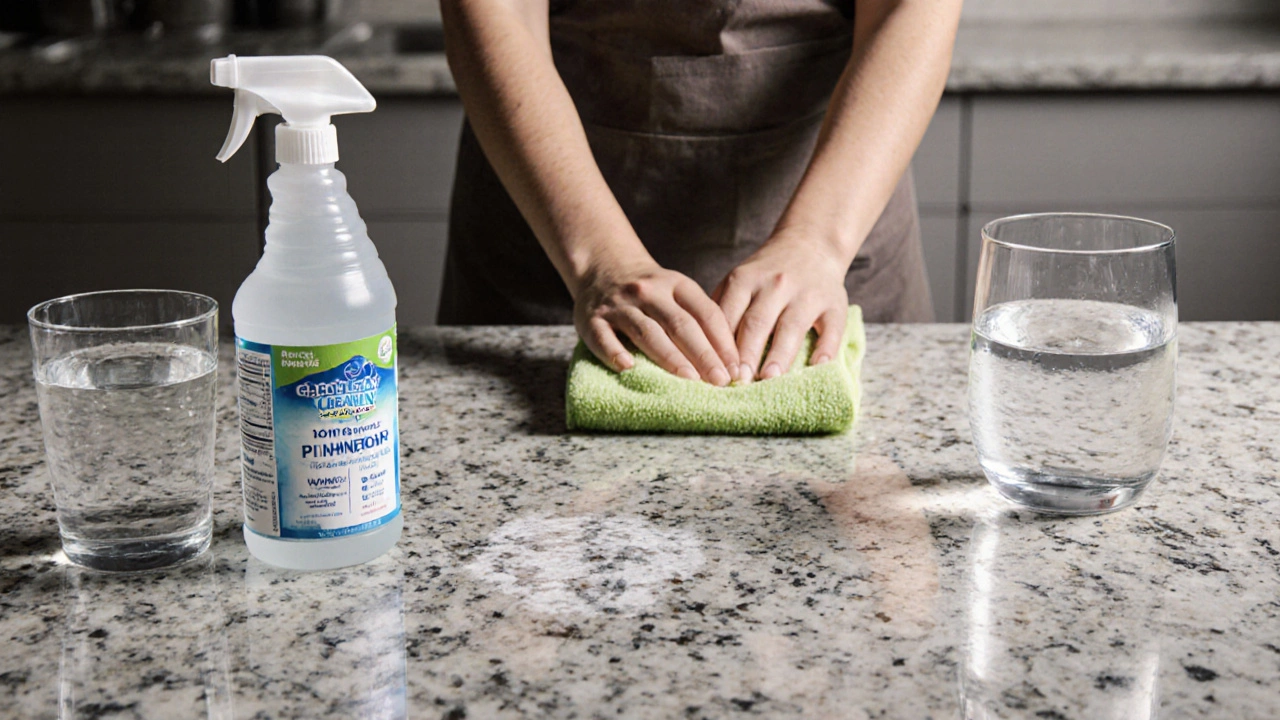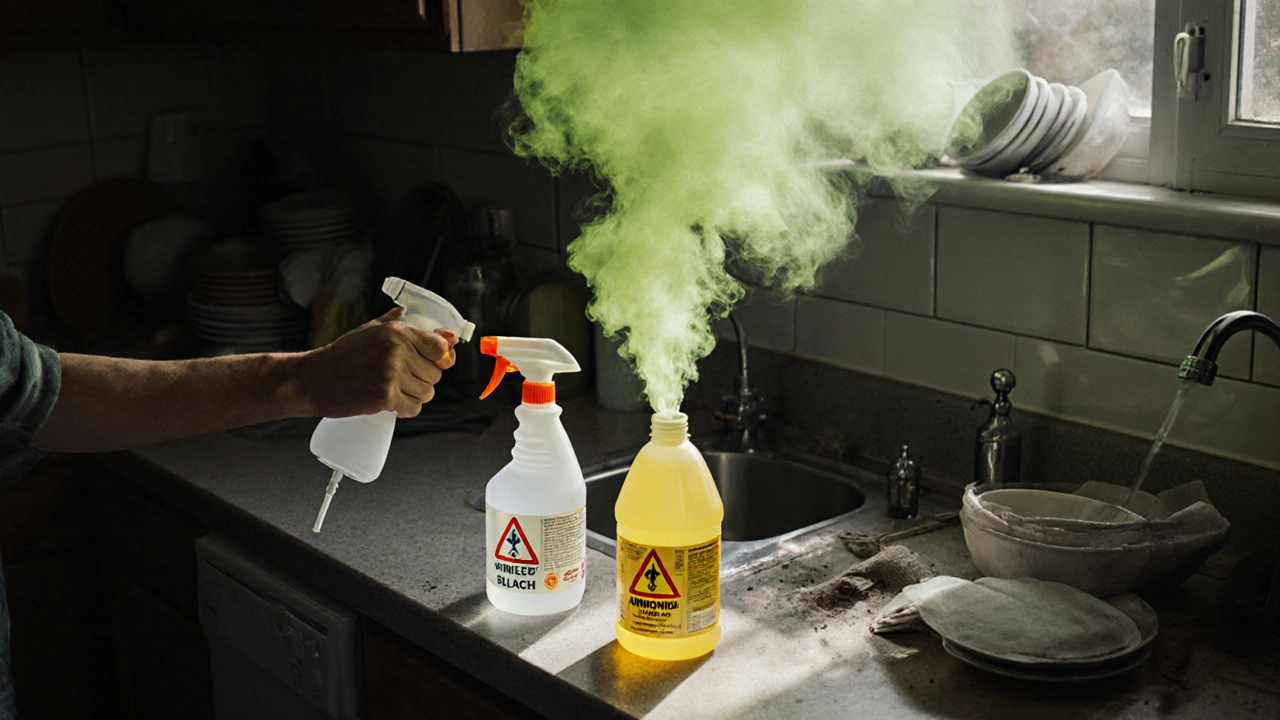Kitchen Cleaning Mistake Checker
Check Your Cleaning Method
Most people think cleaning the kitchen is simple-wipe counters, scrub the sink, and call it a day. But if you’re not careful, you could be making your kitchen dirtier, more dangerous, or even damaging your surfaces without realizing it. I’ve seen too many homeowners ruin granite countertops, strip non-stick coatings, and create toxic fumes just by using the wrong method. It’s not about how hard you scrub-it’s about what you use and how you use it.
Don’t mix cleaning products, especially bleach and ammonia
One of the most dangerous mistakes people make is mixing household cleaners. Bleach and ammonia are both common in kitchens, but when combined, they create chloramine vapors. These fumes can cause coughing, shortness of breath, chest pain, and even chemical pneumonia. I’ve spoken to people who ended up in the ER after trying to ‘boost’ their disinfectant by adding ammonia to bleach. It doesn’t make it stronger-it makes it deadly.
Even mixing vinegar and hydrogen peroxide is risky. While both are safe on their own, combining them creates peracetic acid, which can irritate your skin, eyes, and lungs. If you need to disinfect after raw meat, use one product at a time. Let the surface dry completely before applying the next. Always read labels. If it says ‘do not mix,’ it means it.
Avoid abrasive scrubbers on non-stick pans and coated surfaces
That steel wool pad might look like it’s doing a great job on a burnt pan, but it’s actually scratching away the non-stick coating. Once that coating is damaged, it starts flaking off into your food. Those tiny particles aren’t toxic in small amounts, but they’re not meant to be eaten either. And once the coating is gone, your pan becomes a sticky mess that’s harder to clean than ever.
The same goes for ceramic-coated cookware, enamel finishes, and even some stainless steel sinks. Use soft sponges, microfiber cloths, or nylon brushes instead. For stuck-on food, soak the item in warm, soapy water for 15-20 minutes. Then gently scrape with a wooden or silicone spatula. You’ll save your cookware and your sanity.
Never use vinegar on stone countertops
Vinegar is often called a ‘natural cleaner,’ and it works great on glass and stainless steel. But if you have granite, marble, limestone, or quartzite countertops, vinegar is a bad idea. These stones are porous and sensitive to acid. Vinegar can etch the surface, leaving dull spots that look like water stains but won’t wipe off. Over time, it breaks down the sealant, letting in grease, coffee, and wine stains that become permanent.
I’ve seen kitchens where people cleaned their countertops with vinegar every day for months. By the time they noticed, the surface had lost its shine and looked like it had been sandblasted. Use pH-neutral stone cleaners instead, or just warm water with a drop of dish soap. Wipe dry right away. That’s all you need.
Don’t spray cleaner directly on appliances
It’s tempting to spray all-purpose cleaner right onto your stainless steel fridge, oven door, or microwave. But that’s how you get streaks, residue buildup, and even damage to electronic controls. Cleaners can seep into seams around buttons, handles, and displays, causing malfunctions. On stainless steel, sprays can leave water spots and make fingerprints more visible.
Instead, spray the cleaner onto a microfiber cloth. Wipe the surface gently, then dry with a second clean cloth. For stainless steel, wipe in the direction of the grain. For touchscreens or control panels, use a barely damp cloth-no chemicals at all. If your appliance has a manufacturer’s cleaning guide, follow it. Most brands recommend water only for control panels.

Don’t ignore the backsplash and grout
Most people clean the countertops, the sink, and the stove-but forget the backsplash. Grease, splatters, and steam build up there over time, especially behind the stove. If you don’t clean it regularly, that grime turns into a sticky, discolored layer that’s hard to remove. And if you’ve got tile grout, it’s a breeding ground for mold and mildew.
Don’t just wipe it with a damp cloth. Use a soft brush and a paste made of baking soda and water. Gently scrub the grout lines, then rinse with warm water. For stubborn mold, use a hydrogen peroxide spray (not bleach) and let it sit for 10 minutes before scrubbing. Seal grout every 6-12 months if you have porous tiles. It’s a small step that saves hours of scrubbing later.
Don’t use the same cloth for everything
Using one dish towel to wipe the counter, then the sink, then the fridge handle? That’s how bacteria spread. A damp cloth picks up raw meat juices, then transfers them to surfaces you touch with your hands. Studies show kitchen sponges and cloths can harbor more bacteria than a toilet seat.
Use color-coded cloths: red for raw meat areas, blue for counters, green for appliances, and white for glass and mirrors. Wash them after every use in hot water. Replace sponges every two weeks-even if they still look okay. Microwaving a wet sponge for 1 minute kills most bacteria, but it’s not a long-term fix. Just buy new ones. They’re cheap.
Don’t skip the drain and disposal
The kitchen sink drain is often the dirtiest part of the whole room. Food particles, grease, and soap scum build up inside the pipes and the disposal blades. If you don’t clean it, you’ll get bad odors, slow drainage, and eventually a clog.
Don’t pour boiling water down the drain-it can crack PVC pipes. Don’t use chemical drain cleaners-they corrode metal and harm septic systems. Instead, once a week, pour half a cup of baking soda down the drain, followed by a cup of white vinegar. Cover the drain with a plug or cloth for 10 minutes. Then flush with hot (not boiling) water. Do this monthly for your garbage disposal: toss in a few ice cubes and a lemon peel, then run the disposal for 30 seconds. It cleans the blades and freshens the smell.

Don’t forget to clean the inside of cabinets and drawers
It’s easy to focus on the visible parts of the kitchen. But crumbs, spills, and sticky residue collect inside cabinets, especially near the hinges and along the bottom edges. Over time, this attracts pantry pests-ants, beetles, even moths.
Once every few months, empty your cabinets. Wipe down the shelves with a damp cloth and mild soap. Check expiration dates. Store dry goods in airtight containers. Clean the drawer slides with a dry cloth to remove grit. A quick wipe-down prevents bigger problems later.
Don’t use the wrong type of mop for your floor
Some people use steam mops on wood floors, thinking it’s a deep clean. But steam can warp wood, cause swelling, and ruin the finish. Others use vinegar-based cleaners on vinyl or laminate, which can dull the surface over time.
Check your flooring type. For tile, a damp microfiber mop with a pH-neutral cleaner works fine. For wood, use a cleaner specifically made for hardwood. For vinyl and laminate, use a dry or slightly damp mop with a product labeled safe for those surfaces. Always follow the manufacturer’s instructions. And never leave standing water on any floor.
Don’t clean when you’re rushed or distracted
The worst cleaning mistakes happen when you’re in a hurry. You grab the first bottle you see, spray it everywhere, and move on. That’s how you miss spots, use too much product, or accidentally damage something.
Take five minutes to plan. Know what surfaces you’re dealing with. Pick the right tool. Work slowly. Clean one area at a time. You’ll do a better job and avoid accidents. Your kitchen-and your future self-will thank you.





